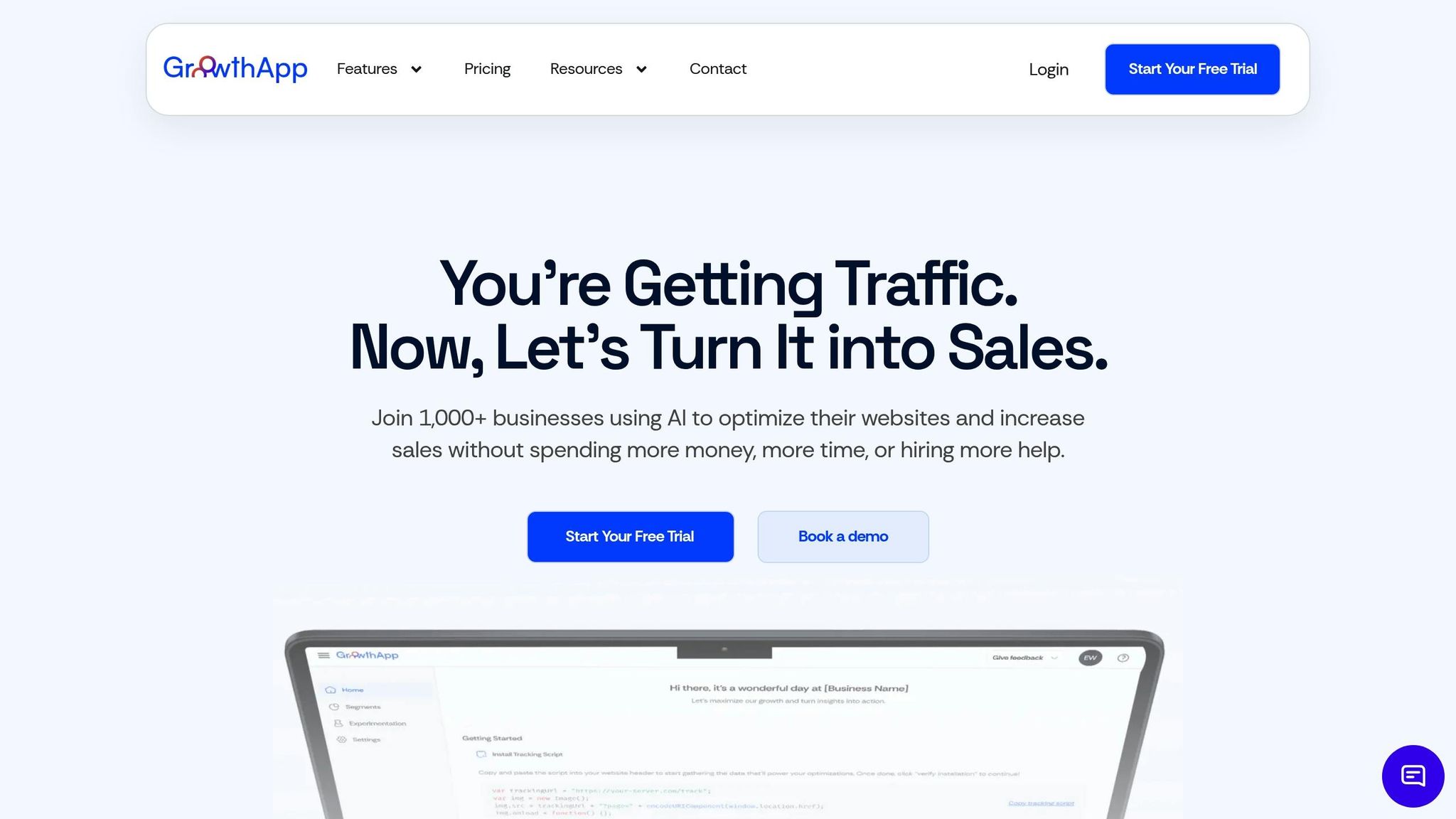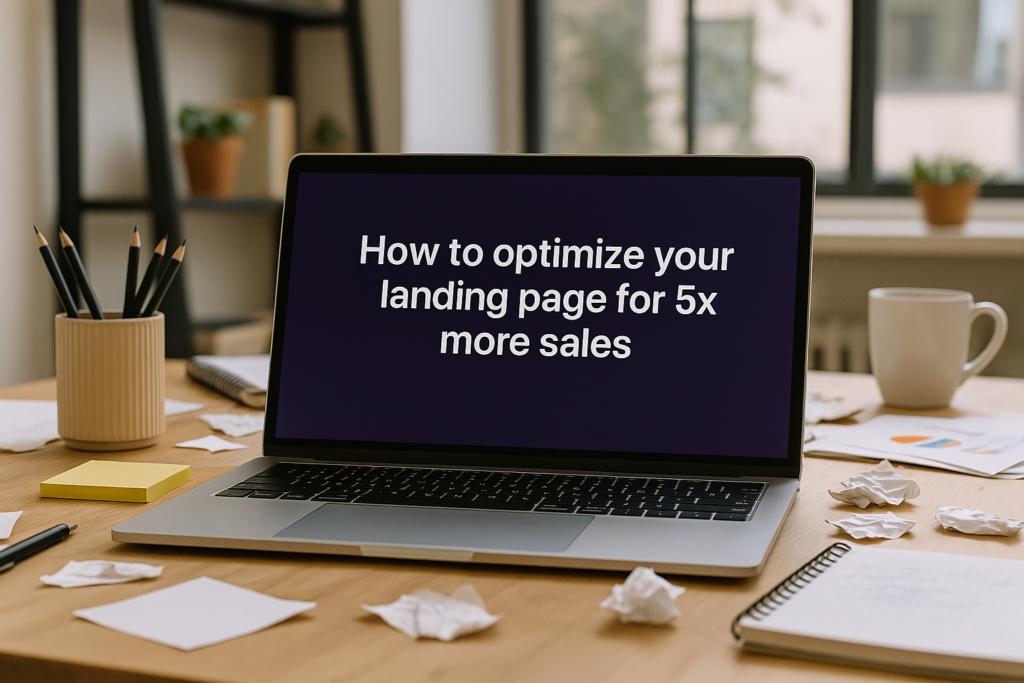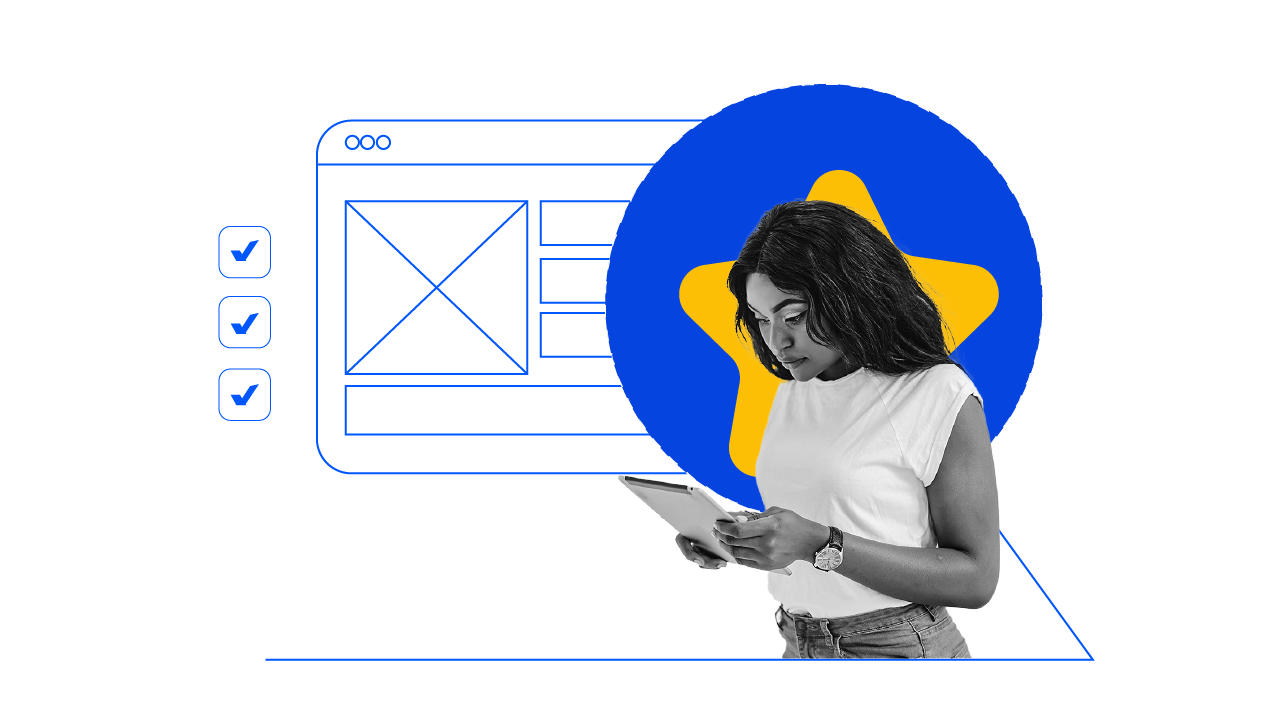Want more conversions? Start with these landing page tips:
- Key Stats: The average landing page converts at 4.3%, but small tweaks (like button color) can boost conversions by up to 34%.
- Why Pages Fail: Slow load times, cluttered layouts, generic visuals, and too many CTAs drive users away.
- What Works: Personalized content, clean designs, fast page speeds, and data-driven A/B testing.
- AI Tools: Solutions like GrowthApp AI can provide the exact optimization strategies you need to 5x your sales by analyzing and segmenting visitor behavior in real time.
Quick Fixes to Try Today:
- Simplify your page design – focus on one clear goal.
- Speed up load times by optimizing images and code.
- Personalize CTAs and headlines for better user engagement.
Landing page optimization isn’t a one-time task. Regular updates, testing, and tracking key metrics like bounce rates and conversion events can help turn visitors into loyal customers.
Landing Page Optimization: The Anatomy of a High …
Main Landing Page Problems
Understanding why landing pages fail to perform well is key to improving them. Even small issues can lead to fewer conversions and lower user engagement.
Why Users Leave Pages
Slow page loading times are a major reason visitors leave. Nearly half of users expect a page to load in under two seconds, and delays can lead directly to abandonment. With nearly 60% of website traffic coming from mobile devices, speed is even more critical.
Other factors that cause users to leave include:
- Confusing layouts that make navigation difficult
- Generic stock photos that feel insincere
- Too many calls-to-action (CTAs), leading to indecision
- Unanswered questions or concerns that leave visitors frustrated
"Landing pages play a significant role in turning curious web visitors into paying customers. In addition to generating business opportunities, they help make an excellent first impression, cultivating trust and credibility among prospects." – Sam Dadofalza, Content Writer, Thrive
These issues not only drive users away but also hurt conversion rates.
Poor Conversion Performance
Low conversions often result from weak page design and poor user experience. Case studies show how small changes can make a big difference:
| Company | Change Made | Result |
|---|---|---|
| Goldelucks | Personalized offers | 12.27% increase in orders |
| Cadbury India | Added video personalization | 33.6% boost in conversions |
| Chad Rubin (Amazon) | Improved product descriptions | Conversion rate jumped from 26% to 46% |
Using AI can improve conversion rates by about 20% on average, and personalized CTAs lead to 42% more conversions.
In addition to poor design, missing or incomplete data analysis often prevents effective decision-making.
Missing Data Analysis
Without tracking the right metrics, you’re left guessing. Here’s what the data shows:
- 88% of online visitors won’t return after a bad experience
- 80% of consumers are more likely to convert with personalized experiences
- 84% of marketers are using or planning to use AI in their strategies
For example, PatientGain used AI alongside traditional marketing and tripled its conversion rate in one year. Spotify also leveraged AI personalization to increase listening hours by 60%.
To improve landing pages, focus on tracking:
- Heatmaps to see where users click
- Scroll depth to understand how far users explore
- Time spent on the page
- Drop-off points in the conversion funnel
- A/B testing to compare different designs
Using robust analytics tools can close these data gaps, helping you refine and improve your landing pages over time.
Effective Landing Page Methods
Building on common landing page pitfalls, these methods focus on improving user experience and performance to drive conversions. Optimizing a landing page involves tailoring content, applying smart design principles, and enhancing technical performance to achieve measurable success.
Content Customization
Tailored content that adapts to user behavior can significantly improve conversion rates. Here are some examples:
| Personalization Method | Company Example | Impact |
|---|---|---|
| PPC Message Match | California Closet | 115% more form submissions |
| Geo-Location Targeting | Nationwide Insurance | Gold ribbon for PPC landing pages |
| Simplified Segmentation | Iomega (now LenovoEMC) | 110% more form completions |
To make content more personalized:
- Match headlines with ad copy to maintain consistency.
- Use location-based imagery to connect with users.
- Simplify segmentation to make the process smoother for visitors.
"The visitor context is the new King in town!"
- Giles Adam Thomas, Conversion Rate Optimization Writer at Acquireconvert.com & Founder of WholeDesignStudios.com
Once content is personalized, focus on the design to guide user interaction.
Design and Layout Best Practices
A well-thought-out design can naturally lead visitors toward conversion. Use these principles to create effective layouts:
- Keep the design clean and uncluttered to avoid overwhelming users.
- Use directional cues, like arrows or images of people pointing, to highlight your call-to-action.
- Limit exit points to keep visitors focused on completing their goal.
- Ensure the design matches the ad or link that brought users to the page.
- Include high-quality visuals that reinforce your message.
Simple, focused layouts help communicate your value clearly. After refining the design, shift attention to technical performance.
Page Speed Improvements
Fast-loading pages are crucial for retaining visitors and improving conversions. Here are some ways to boost page speed:
-
Image Optimization
- Compress and format images to maintain quality while reducing file size.
- Use lazy loading for images below the fold to speed up initial load times.
-
Code Optimization
- Minify CSS, JavaScript, and HTML to reduce file sizes.
- Combine files to cut down on HTTP requests.
-
Technical Implementation
- Enable browser caching to improve load times for returning visitors.
- Reduce server response time to ensure quick access.
- Limit plugin usage to avoid unnecessary slowdowns.
- Optimize for mobile devices to cater to on-the-go users.
- Use tools like Google Analytics to monitor and maintain page speed.
Regularly testing and maintaining your page’s speed ensures it performs at its best.
sbb-itb-22854bb
Landing Page Mistakes to Fix
Correcting common mistakes is crucial to making landing pages as effective as possible. Identifying and addressing these issues can significantly improve performance.
Content Overload
Too much information can overwhelm visitors and hurt your conversion rates. The goal is to provide just enough content to encourage action.
| Content Element | Common Mistake | Better Approach |
|---|---|---|
| Value Proposition | Long, complex paragraphs | Keep it to three sentences or less |
| Form Fields | Asking for too much information | Only request essential details |
| Page Layout | Cluttered design with multiple CTAs | Focus on one clear goal |
Here’s how to prevent content overload:
- Use bullet points to highlight benefits clearly.
- Eliminate unnecessary form fields.
- Create a clean visual hierarchy.
- Stick to one primary call-to-action for clarity.
Overloading content isn’t the only problem – ignoring accessibility can also hurt your page’s performance.
Poor Accessibility
Overlooking accessibility can limit your audience and negatively affect your SEO. Common accessibility issues include:
- Missing alt text for images
- Poor color contrast
- Unclear heading structures
- Designs that don’t work well on all devices
- Fonts and text sizes that are hard to read
By following accessibility standards, you’ll not only reach a broader audience but also improve your search rankings.
Beyond design and content, failing to analyze performance data can undermine your efforts.
Ignoring Data
Skipping data analysis means missed opportunities and wasted resources. Research shows that businesses with 31 to 40 landing pages generate seven times more leads than those with only five pages.
"Achieving success requires ongoing landing page optimization, monitoring, and effective marketing strategies. It’s crucial for businesses to consider user behavior and make data-driven decisions when reviewing landing page performance. Failing to do so can result in the following consequences that directly impact your business’s bottom line." – Waseem Bashir, CEO, Apexure
Key metrics to track:
-
Conversion Events
Monitor both small and large conversion actions to understand user behavior. While the global average conversion rate is around 2.5%, optimized pages can reach up to 11.45%. -
Technical Performance
Keep an eye on page load times, bounce rates, and engagement metrics. For example, using real photos can boost conversions by 35%.
Fixing these issues will strengthen your landing pages and help you achieve better results.
GrowthApp AI Features for Landing Pages

GrowthApp AI streamlines landing page optimization with tools that analyze visitor behavior and provide insights to power your entire marketing strategy and landing page optimization strategy. Here’s a closer look at its standout features designed to help businesses achieve better results.
User Segmentation Tools
GrowthApp AI personalizes user experiences by analyzing visitor behavior in real time. It adjusts content automatically based on factors like:
| Segmentation Factor | Personalization Approach | Impact |
|---|---|---|
| Browsing History | Tailored product recommendations | Higher engagement |
| Demographics | Customized messaging | Greater relevance |
| Device Type | Optimized layouts | Better usability |
| Geographic Location | Location-specific content | Increased conversions |
Personalized calls-to-action (CTAs) have been shown to deliver a 42% higher conversion rate compared to generic ones. GrowthApp AI continuously fine-tunes its segmentation by learning from user interactions, ensuring your strategy evolves over time.
Testing and Analytics
GrowthApp AI simplifies testing by running real-time experiments and implementing successful changes automatically. Key features include:
- Instant analysis of visitor behavior
- Automated A/B testing
- Real-time adjustments for improved performance
“We finally understand what our visitors are doing, and what to do about it.” – David, Growth Manager
This hands-off approach makes it easy to implement effective changes quickly.
Setup and Implementation
Getting started with GrowthApp AI is simple and doesn’t require technical expertise. Install the tracking script, let the AI analyze your visitors, and get insights – often within minutes, without any coding.
“We improved our ad performance in a week just by following Growie’s insights.”
Conclusion
Landing page optimization has entered a new era with AI tools taking the lead. These tools analyze extensive visitor data and implement changes automatically, making conversion rate optimization (CRO) faster and more efficient.
Data shows that companies using AI experience a 20% boost in conversions. This increase stems from AI’s ability to analyze large datasets and make real-time adjustments without manual intervention.
Industry Insights:
| Industry | Results |
|---|---|
| E-commerce | 30% more recovered carts |
| SaaS | 42% increase in signups |
| Consultancy | 2x lead conversions |
"It’s easy to think you need more traffic to make more money for your company. GrowthApp shows us we only need to work smarter. I think the best part is we didn’t need to do it ourselves." – Melanie Shudofsky, Shudofsky Coaching
These results highlight the importance of combining AI automation with established strategies. Automated testing, personalized user experiences, and data-driven decisions allow businesses to grow without increasing their budgets or team sizes.
Setting clear goals remains a critical step. Zachary Murray, Founder of Foreplay, puts it best:
"The first step in my landing page testing checklist is to set clear, measurable goals. Without a defined objective, it’s impossible to gauge the effectiveness of your tests".
With AI projected to contribute $13 trillion to the global economy by 2030, businesses that adopt these tools now are positioning themselves for long-term success. Blending human insight with AI-driven solutions creates a strong foundation for ongoing landing page performance.

